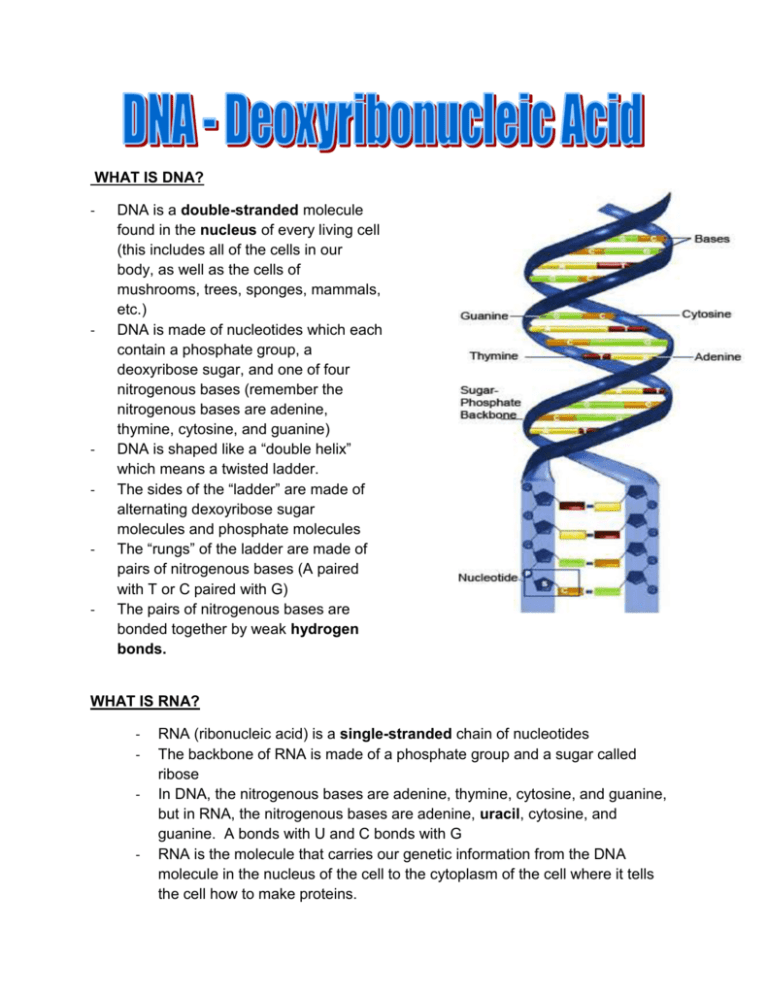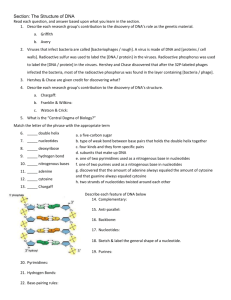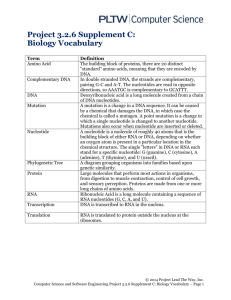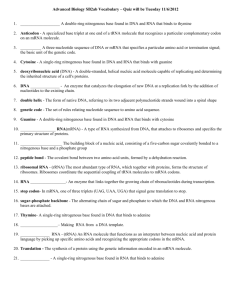Bio 30 DNA Notes
advertisement

WHAT IS DNA? - - - - - DNA is a double-stranded molecule found in the nucleus of every living cell (this includes all of the cells in our body, as well as the cells of mushrooms, trees, sponges, mammals, etc.) DNA is made of nucleotides which each contain a phosphate group, a deoxyribose sugar, and one of four nitrogenous bases (remember the nitrogenous bases are adenine, thymine, cytosine, and guanine) DNA is shaped like a “double helix” which means a twisted ladder. The sides of the “ladder” are made of alternating dexoyribose sugar molecules and phosphate molecules The “rungs” of the ladder are made of pairs of nitrogenous bases (A paired with T or C paired with G) The pairs of nitrogenous bases are bonded together by weak hydrogen bonds. WHAT IS RNA? - - RNA (ribonucleic acid) is a single-stranded chain of nucleotides The backbone of RNA is made of a phosphate group and a sugar called ribose In DNA, the nitrogenous bases are adenine, thymine, cytosine, and guanine, but in RNA, the nitrogenous bases are adenine, uracil, cytosine, and guanine. A bonds with U and C bonds with G RNA is the molecule that carries our genetic information from the DNA molecule in the nucleus of the cell to the cytoplasm of the cell where it tells the cell how to make proteins. **Complete the following table which summarizes the similarities and differences between RNA and DNA... DNA RNA Only one type (DNA) Three types – mRNA, tRNA, rRNA Name Types Structure (Singlestranded or Double Helix) Backbone Nitrogenous Bases Function WHAT DOES DNA HAVE TO DO WITH HEREDITY? - - - DNA is made up of thousands of genes all coiled together into structures called chromosomes Each gene carries a recipe for how to make the proteins our body needs DNA is often thought of our body’s “blueprint”....it provides the instructions for how to make us (eye colour, shape, nose shape, height, etc.) just like a house blueprint provides the instructions for how to make a house. WHY ARE PROTEINS IMPORTANT TO OUR BODIES? **To do: Look in any biology textbook and find at least five things that proteins do in our bodies or structures that proteins make in our bodies 1) 2) 3) 4) 5) HOW DOES DNA TELL OUR BODIES TO MAKE PROTEINS? - We all know that DNA is located in the nucleus of every living cell. What happens to the DNA as a cell divides? Does it split in half? Does this mean that each offspring has half as much DNA as the parent does? We know that offsprings and their parents have the same amount of DNA in each cell. This is because DNA first replicates itself before a cell divides. This replication occurs in the prophase stage of mitosis and meiosis. - Before a cell divides, DNA makes a copy of itself in the process called replication - When our bodies need proteins, genes are transcribed from DNA into RNA in a process called transcription. - The transcribed RNA molecule (called messenger RNA or mRNA) leaves the nucleus of a cell. - Once outside the nucleus, proteins are built based on the “directions” that were carried on the RNA molecule. This process is called translation. REPLICATION - DNA is the only molecule capable of replicating itself This helps to explain how one cell is able to divide into two cells and still carry out all the same functions as the original cell. The steps of replication are: 1) The weak hydrogen bonds between nitrogenous bases are broken 2) The edges of the ladder “unzips” 3) The parent strands of DNA are conserved (intact) therefore the process is known as semi-conservation replication. 4) Free-floating nucleotides in the cell then attach to the two separate parent rungs. Adenine molecules attach to thymine, cytosine to guanine, thymine to adenine and guanine to cytosine. 5) Enzymes called polymerases are responsible for fusing free nucleotides together in the DNA strand - - In case you are wondering, “free-floating” nucleotides come from our food. When we eat cattle, for example, the DNA of cattle is “chopped” up by enzymes in our body leaving the individual nucleotides “free-floating” in the nucleus of our body cells. Our bodies also contain enzymes that act as proof-readers of the replicated sequence. If the enzymes find a damaged section, it can be repaired. The error is snipped and replaced with the correct nucleotide. Answer the following questions... 1) What is the purpose of DNA replication? 2) Where in the cell does DNA replication take place? 3) Why is replication referred to as semi-conservative? 4) Where do free-floating nucleotides come from? TRANSCRIPTION Protein synthesis (remember “synthesizing” means to make something) begins once the double-stranded DNA molecule unzips. As the molecule of DNA begins to uncoil, nucleotides from messenger RNA (mRNA) begin to pair up with the appropriate DNA nucleotides. Cytosine pairs with guanine and adenine pairs with uracil. Remember that RNA contains uracil instead of thymine which is why A pairs with the U in RNA rather than T. Once the chain has been fused, the single-stranded mRNA molecule begins to move away from the parent DNA. The two original strands of DNA rejoin with one another and single-stranded mRNA moves through the nuclear membrane carrying the nitrogenous base code out into the cytoplasm of the cell. Summarize the steps of transcription from the paragraph above... TRANSLATION Before you begin, use your textbook to define the following terms: Codon – tRNA Anticodon Initator CodonTerminator Codon - In the process of translation, the mRNA molecule first attaches to a ribosome - The initiator codon (AUG) turns on protein synthesis - Transfer RNA (tRNA) picks up amino acids that a floating around in the cytoplasm of the cell and carries them to the mRNA molecule (still attached to the ribosome) - Amino acids are held in place at one end of tRNA while the other end has three nitrogenous bases exposed (called anticodons) - Each tRNA has a specific anticodon - mRNA strand attached to the ribosome will select the tRNA molecule if the codon and anticodon pairs match UUU codon = AAA anticodon - tRNA places its amino acid in the ribosome and moves away in search of another amino acid - A new codon for mRNA is then exposed and available for another tRNA to match up. - Amino acids continue to fuse into long chain proteins on the ribosomes - Once the protein has been built, a terminator codon turns protein synthesis off and translation is then complete. Using the genetic code on the next page, answer the following questions... 1) How many letters do codons and anticodons consist of? 2) Which codons start protein synthesis and which codons turn protein synthesis off? 3) Which amino acids would be formed from the following DNA code: ATGCGATGCCATTCATGA 4) The amino acid Leucine is formed by which codons? 5) What would be the four different anticodons that could possibly be at the end of a tRNA molecule carrying the leucine amino acid? 6) Look up the genetic disorder PKU. What happens when the body does not have enough of the amino acid phenylalanine?









